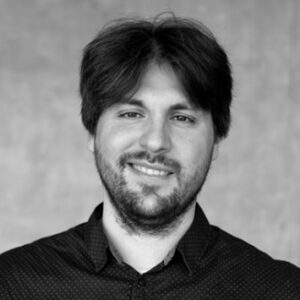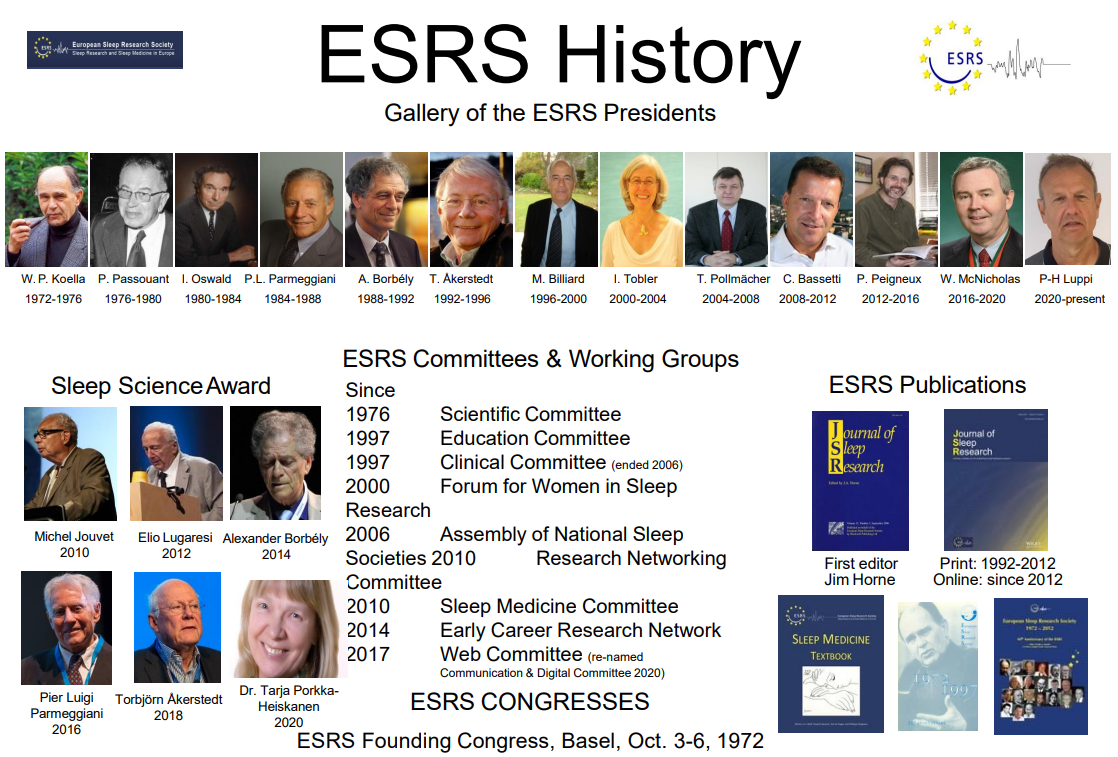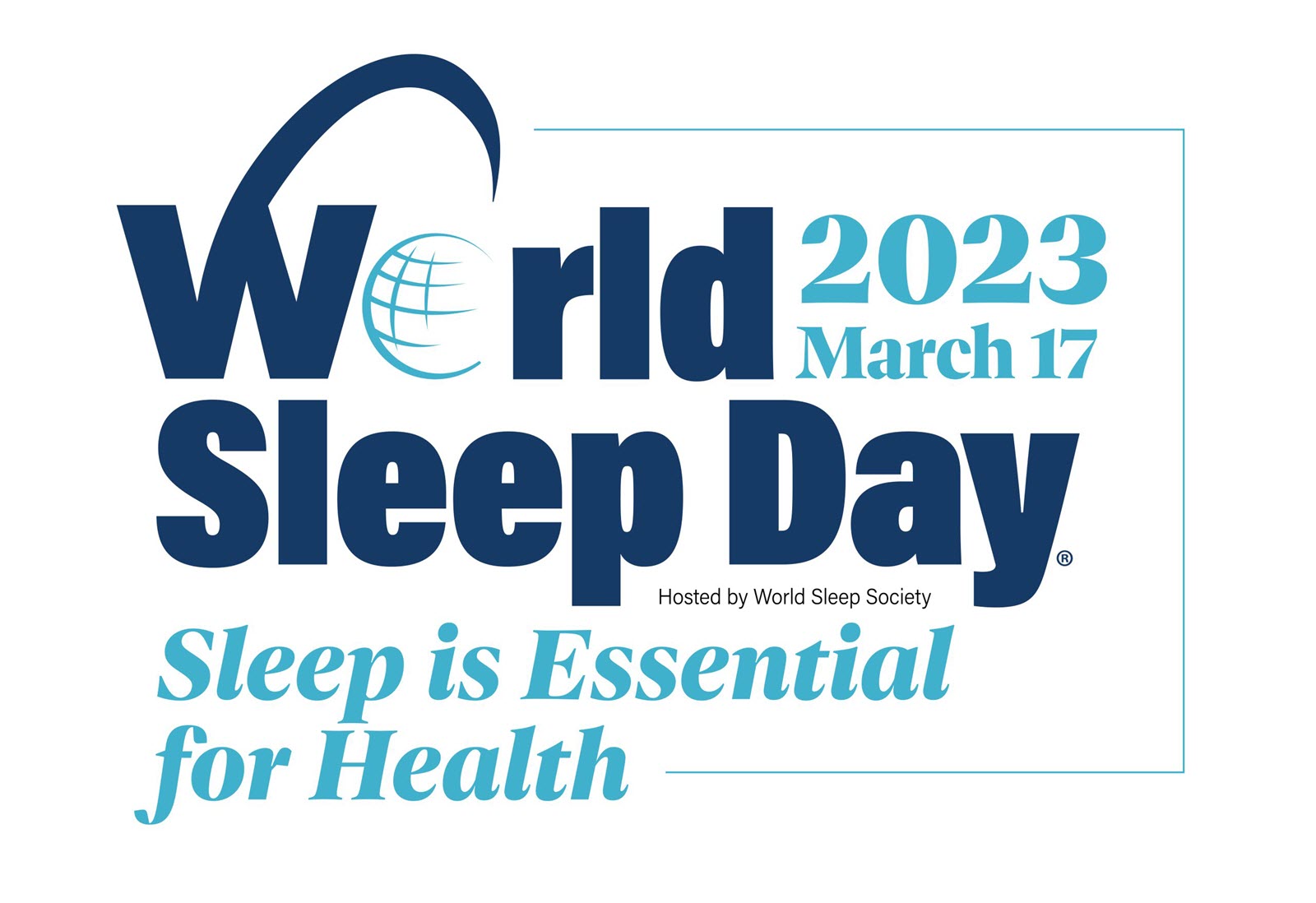ESRS recognises World Sleep Day 2023 with Webinar in Obstructive Sleep Apnea
Like nutrition and physical activity, sleep is also a vital component of health, influencing your physical and mental wellness and social life. In honour of today’s World Sleep Day, the 17th of March 2023, which was founded by World Sleep Society, we aim to raise awareness about the significance of sleep. In accordance with this year’s World Sleep Day 2023 theme, “Sleep is essential for health”, we share in this Sleep Science Friday a report on the webinar “Hot Topics in Obstructive Sleep Apnea – A European View”, hosted by the ESRS on March 10, 2023. This ESRS webinar report was co-authored by Matias Rusanen and Dimitri Ferretti who gave their personal intakes after attending the webinar.
In strong relation to these Obstructive Sleep Apnea (OSA) topics discussed in the webinar, we would also like to call your attention to the forthcoming event “Sleep and Breathing Conference”, next 20 to 22 April 2023 (go next for programme and registration), and to the European project “Sleep Revolution”, that is tailoring machine learning algorithms to assess OSA severity and treatment needs (find out more about Sleep Revolution project).
ESRS OSA Webinar Attendees Report

By Matias Rusanen
PhD student at the Department of Technical Physics, University of Eastern Finland and Diagnostic Imaging Center, Kuopio University Hospital
“On March 10, 2023, I attended a seminar titled ” ESRS Webinar: Hot Topics in Obstructive Sleep Apnea – A European View” by ESRS. The seminar discussed the future of obstructive sleep apnea (OSA) diagnosis and treatment.”

By Dimitri Ferretti
PhD student at the Department of Psychology, Reykjavik University. Sleep Revolution
“The latest online seminar organized by ESRS, March 10th, 2023, led to the presentation of 5 key points moderated by Prof. Dr. Dirk Pevernagie. The common thread that united the presentations was the importance given to the “European” point of view regarding some of the most recent and future highlights in the field of Obstructive Sleep Apnea (OSA). The interest in this European point of view has been set in motion by the new and ever-increasing contributions that are and will be able to fuel clinical and scientific research in the field of sleep medicine.”
"The Diagnosis of OSA Revolutionized" by Dr. Erna Sif Arnardottir
Matias Rusanen: “Dr. Erna Sif Arnardottir discussed how the traditional diagnosis of obstructive sleep apnea (OSA) involves an overnight in-laboratory polysomnography (PSG) test. However, advancements in technology have led to alternative diagnostic methods that are less invasive and more accessible to patients. These include home sleep apnea tests (HSAT) and associated self-applicable sensors. Dr. Arnardottir emphasized the importance of validating these diagnostic methods and ensuring they provide accurate results before implementing them in clinical practice. She also discussed the need for individualized diagnostic approaches, considering patient characteristics and clinical presentation. There was great interest in the three-night vs. one-night sleep study which elaborated interesting discussion. I was particularly interested in the data showing a significant increase in sleep quality from the first night to the third night. Overall, this talk highlighted the potential for new and innovative diagnostic methods to improve the diagnosis and management of OSA.”
Dimitri Ferretti: “Dr. Arnardottir, from Iceland, is the principal investigator of the Sleep Revolution project and has focused her presentation on the importance and possibility of moving the diagnosis of sleep disorders from the hospital to the patient’s home. The main topic focused on the difference between laboratory Type 1 polysomnography (PSG) and Type 2 sleep studies; with a focus on patient self-applied Type 2 studies (Arnardóttir et al., 2021). To be able to move the diagnosis in a domestic environment, some major points (that need to be taken under consideration to drive this change) were underlined:
- a quality of signals and scoring compared to PSG is needed,
- a good quality of self-applied studies is needed as well,
- it is also very important, in the first steps, to take under consideration the patient experience with these new self-applied devices,
- the aim is also to reach a validation for relevant groups (e.g., pediatrics, adults etc.),
- to really see an improvement in the costs it is necessary to validate automatic analysis (otherwise it will be useless to gains in terms of data quantity without a decrease in time for scoring).”
In my personal impression, what I found most interesting on this first part (and I am talking with personal involvement and knowledge from the Sleep Revolution project) is the possibility to move sleep study to a more accessible and less expensive, in terms of costs and time technology (but a good automatic scoring algorithm is needed to make this possible). An important improvement would be the possibility to have multiple consequential nights of sleep studies within the same patient.
"OSA and Comorbidities" by Prof. Dr. Maria Bonsignore
Matias Rusanen: “Prof. Dr. Bonsignore discussed the prevalence of comorbidities in OSA patients and emphasized the need for multidisciplinary cooperation in their management. The seminar highlighted possible bidirectional relationships between OSA and other diseases. It was informative and engaging, providing insights into the comorbidity burden around OSA and the need for optimal management. Prof. Dr. Bonsignore’s expertise and passion for the subject matter were evident in the seminar, making it an enjoyable and enlightening experience.”
Dimitri Ferretti: “Bonsignore talked about comorbidities starting from a short definition of the meaning of “comorbid.” She started presenting a study showing possible comorbidities with OSA and indicating both prevalence and risk of mortality. After this general introduction, the 3 conditions (Obesity and Metabolic Syndrome, Systemic hypertension, and Type 2 diabetes) that usually present with OSA were presented; finally, another important incidence was presented, which often occurs with OSA (chronic kidney disease). The latter comorbidity shown (chronic kidney disease) seems to be positively influenced by CPAP.
Interestingly, without comorbidities, the mortality risk associated with OSA is extremely low. It was also interesting to see how it seems to suggest that the use of CPAP requires a longer application time to see improvements at the metabolic level and at the same time seems to have a positive influence in case of comorbidity with chronic kidney disease. Therefore, thanks to this presentation, it appears clear that there are certainly bidirectional relationships that need to be better studied in the future between OSA and various comorbidities; emphasizing the point of the speech on the importance of a multidisciplinary approach.
"Evidence-based treatment of OSA" by Prof. Dr. Walter McNicholas
Matias Rusanen: “Prof. Dr. McNicholas discussed evidence-based treatment for OSA, highlighting limitations of the recent AHRQ report failing to support the benefits of CPAP therapy for outcomes including cardiometabolic comorbidity, cognitive function, quality of life, and driving accident risk. Based on the talk, patient selection and primary OSA severity measurement are important in evaluating CPAP outcomes, with for example hypoxemia and daytime sleepiness as predictors of comorbidity. CPAP compliance seems to be also very important, with benefits shown in patients with good compliance.
Furthermore, alternatives to CPAP were discussed, including MAD therapy, weight loss, and pharmacological therapy, with benefits identified in the inflammatory and metabolic aspects of OSA. For me, it was also interesting to hear, because I’m not familiar with the pharmacological therapy of OSA, that medications were reported to have significant benefits in pathophysiological aspects such as upper airway collapsibility, sleepiness, and arousals. It was also mentioned that pharmacotherapy of obesity has been effective in weight reduction in the context of OSA treatment.
Furthermore, I found renal dysfunction as an interesting comorbidity with a bidirectional relationship to OSA, because in these cases treating fluid retention could also serve as a treatment for OSA. However, it was noted that non-CPAP therapies for OSA tend to have low/very low-quality of evidence.”
Dimitri Ferretti: “Unfortunately, McNicholas was unable to attend the live presentation but could share a recorded presentation on “Evidence-based treatment of OSA”. The focus was on recent evidence regarding the efficacy of CPAP therapy for OSA. It has been highlighted how important it is, to better evaluate the efficacy of CPAP, a selection of patients and an accurate measurement of the primary OSA severity measurements. Also, not to be overlooked is therapeutic compliance in order to obtain satisfactory results from therapy. This presentation also underlined the importance of the bidirectionality of the relationships of comorbidities with OSA. PAP treatment seems to have a positive effect even if other therapeutic approaches are indicated (pharmacological, weight loss, mandibular modeling) as potential or side approach.
In addition to the importance of the bidirectionality between OSA and comorbidity mentioned again, I found it interesting to see how significant impact and importance is given to patient compliance with the therapeutic plan in order to have “satisfactory” improvements. Interesting even if far from my field of study was the conclusion on the importance given to a personalized approach for the patient to obtain the best OSA treatment.”
"To treat or not to treat? the Baveno perspective" by Prof. Dr. Winfried Randerath
Matias Rusanen: “The talk by Prof. Dr. Winfried Randerath discussed the limitations of using the number of breathing disturbances during sleep as an indication for OSA treatment, as there is only a weak correlation between this index and symptoms/outcomes. At the beginning of the talk, Dr. Randerath gave an interesting review of the latest literature on the phenotypic clustering of OSA patients and discussed how the response to CPAP as an outcome differs between the phenotypic clusters. He continued showing that CPAP adherence is also limited, especially in patients with minor symptoms. New concepts for selecting patients for positive airway pressure treatment were discussed, including classification systems that focus on patient-relevant outcome parameters and prognosis.”
Dimitri Ferretti: “Prof. Dr. Randerath focused the presentation on the “when/if to treat patients” dilemma. Starting to talk about the current method of diagnosis and focusing on AHI, it was highlighted how we can see a correlation with sleepiness and other symptoms (e.g., alertness) mainly for those patients showing an AHI ≥30. This point of view could therefore move the historical method of evaluation towards a new and more accurate method. Research is currently focusing on the study and identification of phenotypes. What is presented and defined as the “Baveno perspective” is the idea of using different dimensions (breathing disturbances, systemic effects/symptoms, comorbidities / consequences) instead of the single AHI (used as a prerequisite) to decide whether to implement or not the treatment.
Probably influenced by the approach of the project I am currently a part of, I find this idea of moving towards an innovative approach to clinical analysis and evaluation interesting. Indeed, I found the Baveno perspective interesting as an idea of deviating from the AHI as a single marker (whether or not treatment is needed). Interesting the conclusion with the discussion about how to select whether a patient is or not suitable for treatment.”
National knowledge-driven management of OSA - the Swedish approach - Prof. Dr. Ludger Grote
Matias Rusanen: “Sweden has launched a national initiative to improve the knowledge-based management of obstructive sleep apnea (OSA) patients. The OSA care program focuses on harmonizing the diagnostic process and implementing a treatment decision matrix based on available evidence. A national expert group developed the program, which includes national guidelines, a care plan, and a quality registry for monitoring care. The program is being implemented nationwide, with outcomes being monitored by the Swedish sleep apnea registry. For me, it was interesting to see data on the decentralized healthcare in Sweden and reflect on our areal differences in Finland.
The panel discussion at the end of the webinar revised aspects of the talks and answered participants’ questions. For example, the three-night sleep study and the three results following the protocol were discussed further. Dr. Arnardottir provided the information that the upcoming prospective studies of the Sleep Revolution project could answer these questions. Dr. Randerath ended the panel discussion with a critical point highlighting that the aim of the future diagnosis and treatment of OSA is in high-quality medicine. He reflected on the importance of preselection protocol for OSA patients to achieve better-targeted medicine in the future.”
Dimitri Ferretti: “Prof. Dr. Ludger Grote presented the approach used in Sweden for the management of OSA. The main components of the Swedish initiative program are based on the presence of three interdependent points: guidelines for diagnosis and treatment, national quality registry and care program Obstructive Sleep Apnea in Adults. The Swedish system is heavily influenced by the suggestions underlying the previously presented “Baveno protocol”. The actions described therefore improve, optimize and support the diagnosis process and the decision flow for the choice of the best usable treatment method.
Interesting, especially as unaware of similar methods of healthcare organization, to see the organization and coordination of each phase and sub-phase of the program presented as flow charts.”
Watch the full webinar and make your own insights!
Recent publications from ESRS members
- Reesen et al. (2023). Do better nights lead to better days? Guided internet-based cognitive behavioral therapy for insomnia in people suffering from a range of mental health problems: Protocol of a pragmatic randomized clinical trial. Contemp Clin Trials.
- Bastien et al. (2023). Posttraumatic Stress Symptoms in Patients With Cancer During the COVID-19 Pandemic: A One-Year Longitudinal Study. J Natl Compr Canc Netw.
- Stee and Peigneux (2023). Does Motor Memory Reactivation through Practice and Post-Learning Sleep Modulate Consolidation? Clocks Sleep.
- Scholz et al. (2023). Metabolomics-based Sleepiness Markers for Risk Prevention and Traffic Safety (ME-SMART): a monocentric, controlled, randomized, crossover trial. Trials.
- Simor, Peigneux & Bódizs (2023). Sleep and dreaming in the light of reactive and predictive homeostasis. Neurosci Biobehav Rev.
- Stee and Peigneux (2023). Does Motor Memory Reactivation through Practice and Post-Learning Sleep Modulate Consolidation? Clocks & Sleep.
- Cesari et al. (2023). Automatic analysis of muscular activity in the flexor digitorum superficialis muscles: a fast screening method for rapid eye movement sleep without atonia. Sleep.
- Purple et al. (2023). Phenotypic divergence in sleep and circadian cycles linked by affective state and environmental risk related to psychosis. Sleep.
- Goldschmied et al. (2023). The sleep homeostatic response to sleep deprivation in humans is heritable. Sleep.
- Palm et al. (2023). Association between obstructive sleep apnoea and cancer: a cross-sectional, population-based study of the DISCOVERY cohort. BMJ Open.
- Dornbierer et al. (2023). Nocturnal sodium oxybate increases the anterior cingulate cortex magnetic resonance glutamate signal upon awakening. J Sleep Res.
- Fulda & Miano (2023). Time to rest a hypothesis? Accumulating evidence that periodic leg movements during sleep are not increased in children with attention deficit hyperactivity disorder (ADHD): results of a case-control study and a meta-analysis. Sleep.



